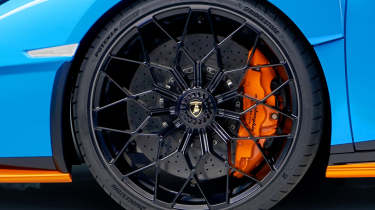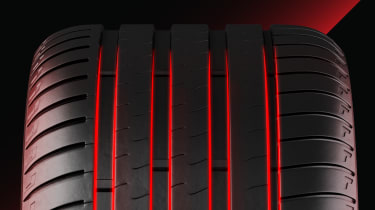The anatomy of an ultra-high performance tyre
There’s a lot going on inside your car’s only contact point with the asphalt
In the world of performance cars, we spend a great deal of time talking about the latest advances in suspension, engines, and more recently, electric powertrains. But to make the most of all those improvements, tyre technology needed progress also, and it certainly has.
This isn’t just about helping deliver blistering Nürburgring Nordschleife lap times, however. Better tyres mean more stability and shorter braking distances both in the wet and the dry, keeping you and your passengers safe. And from an enthusiast’s perspective, superior footwear can provide increased steering and chassis feedback and responsiveness.
A lot goes on behind the scenes to make this possible. Ultra-high performance or ‘UHP/UUHP’ tyres like the new Bridgestone Potenza Sport - a replacement for the highly successful Bridgestone Potenza S001 - are much more complex than you might realise. Here, we’ll take a closer look at this tyre, starting with the testing that led to its creation, then working our way from the outside in to see how it's put together and what that means in the real world.
Testing times
Developing an all-new tyre is an intensive process. Typically, 25,000 on-track miles are covered, necessitating the use of hundreds of tyres. Using proprietary technology, however, Bridgestone can virtually test and tweak new products before physical testing commences.
This cuts down the circuit mileage considerably, yielding a 60 per cent reduction in materials and CO2 emissions while saving around 200 tyres. Along with the ecological benefits, development time is shortened, meaning customers can shod their wheels in improved tyres much sooner.
Physical testing is still a vital part of the process. For the Potenza Sport, this was largely done at Bridgestone’s European proving grounds near Rome, which features a 2.5-mile 37-degree banked oval for high-speed testing, a handling track of the same length and advanced facilities for wet conditions.
Origin of asymmetry
As for the rubber itself, it’s not just a question of what goes into it - which includes reinforcing silica and miscible resin - but also how it’s mixed. In the Potenza Sport, innovative mixing technology helps improve both wet and dry performance and stiffness.
You might have also noticed that the tread pattern isn’t the same on either side of the tyre. This asymmetrical pattern makes the tyre more versatile, with improved performance in different scenarios, while also increasing lateral stiffness and reducing deformation of the tread blocks.
On that subject, the rib and void distribution - which refers to the ‘strips’ of tread running around the tyre’s circumference and the spaces between them - has been carefully optimised for better water clearance and more stable cornering. Meanwhile, the sipes (horizontal lines cut into the ribs to aid water and ice clearance) feature a 3D design, increasing shear stiffness for improved braking performance and abrasion resistance.
Structural engineering
The rubber and the tread are only part of the story - the composition underneath is just as important. For instance, the reinforcement for the crown - the middle section of the tyre’s circumference that spends the most time in contact with the road - is made of a hybrid material rather than the usual polymer.
The steel reinforcement band is strengthened, while the carcass - made up of the layers of cord that give a tyre its structure - is tweaked for stability and sweeter steering response. Finally, the shape of the tyre’s profile is more 'square', giving a larger contact patch with the tarmac.
The results
All of this comes together to provide tangible, provable real-world benefits. TÜV SÜD, the German testing organisation, evaluated the Potenza Sport against its main competitors using an Audi S4, with the Bridgestone tyre coming out on top in both the dry braking and vehicle stability in a straight line/through a curve categories.
The Bridgestone Potenza Sport was awarded highly commended in the evo’s 2021 Tyre Awards.[1] In 2022, the Bridgestone Potenza Sport received the rating ‘very good’ in the summer ultra- and ultra-ultra-high performance tyre test of SPORT AUTO (Size 235/35 ZR 19).[2] The publication’s tyre experts said of the Potenza Sport: “Outstanding and safe cornering characteristics on wet and dry roads linked with surprising good safety for hydroplaning along with high steering agility and preciseness."
Multiple high-end manufacturers have already chosen the Potenza Sport as OE (original equipment) for some of the most exciting new performance cars around right now. Bespoke versions of the tyre are found on the Maserati MC20, Lamborghini Huracan STO and Ferrari Roma from the factory, and that’s just the start.
Plenty of drivers will be able to take advantage of Potenza Sport’s advancements on their existing cars, too. Available in 96 sizes going from 17 to 22 inches, it’s suitable for a wide range of vehicle types, from modern classic sports cars on smaller wheels to the latest performance SUVs.
Learn more about the Bridgestone Potenza Sport
1. Evo 2021: UHP Summer Tire Test R18
2. Sport Auto – edition 04/2022 – summer UHP and UUHP tyre test – test vehicle: HYUNDAI i30 N. – tested size: 235/35 Z R 19 – Rank 3 of 10






